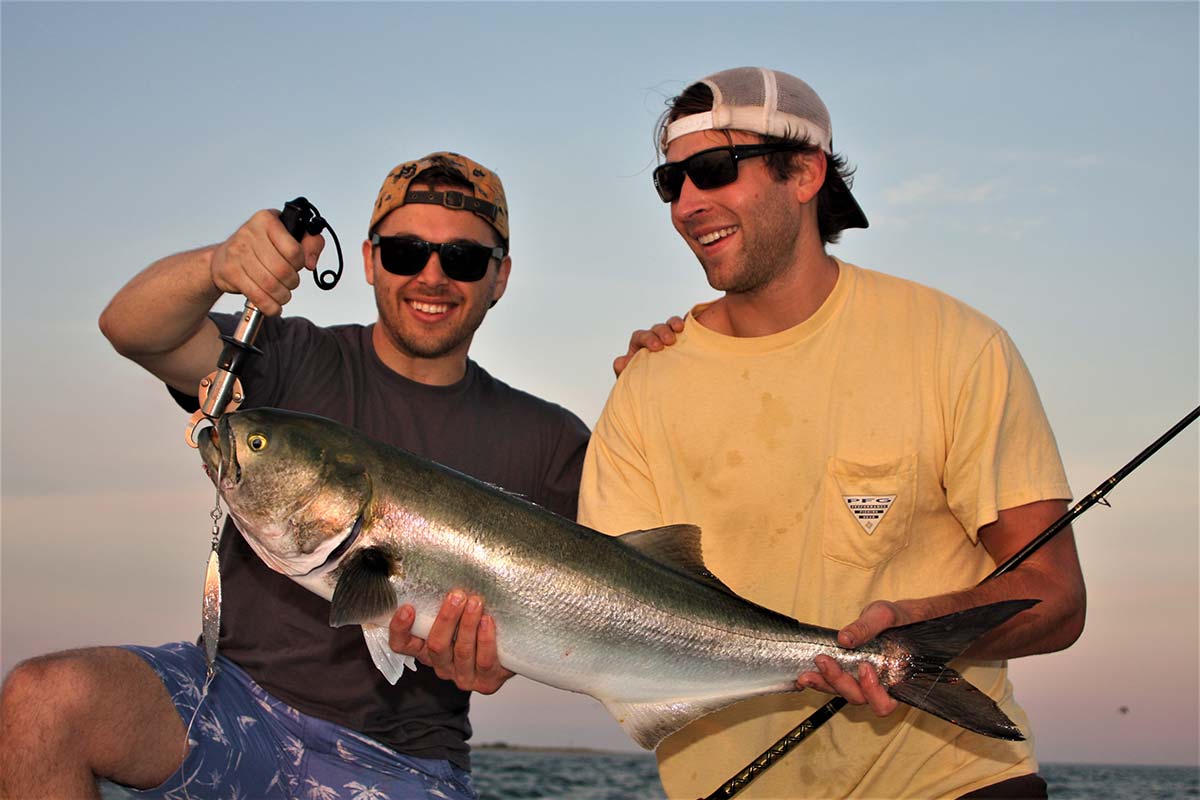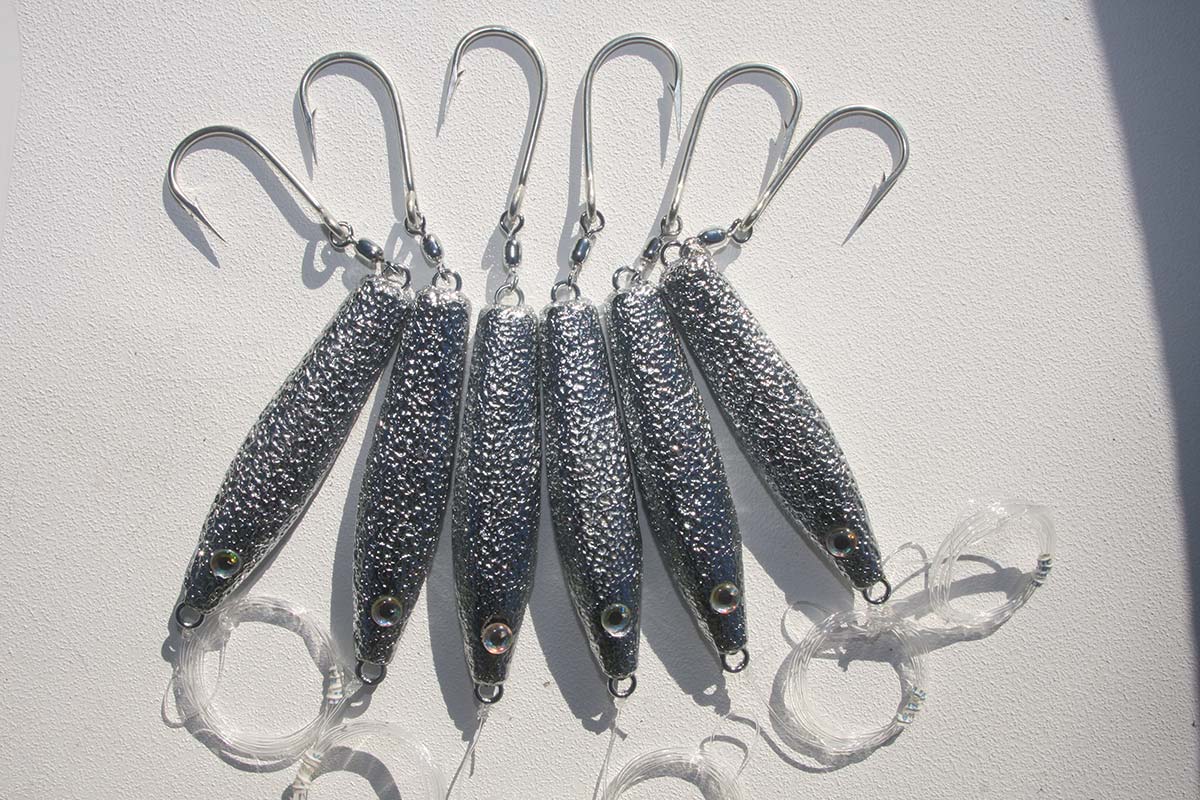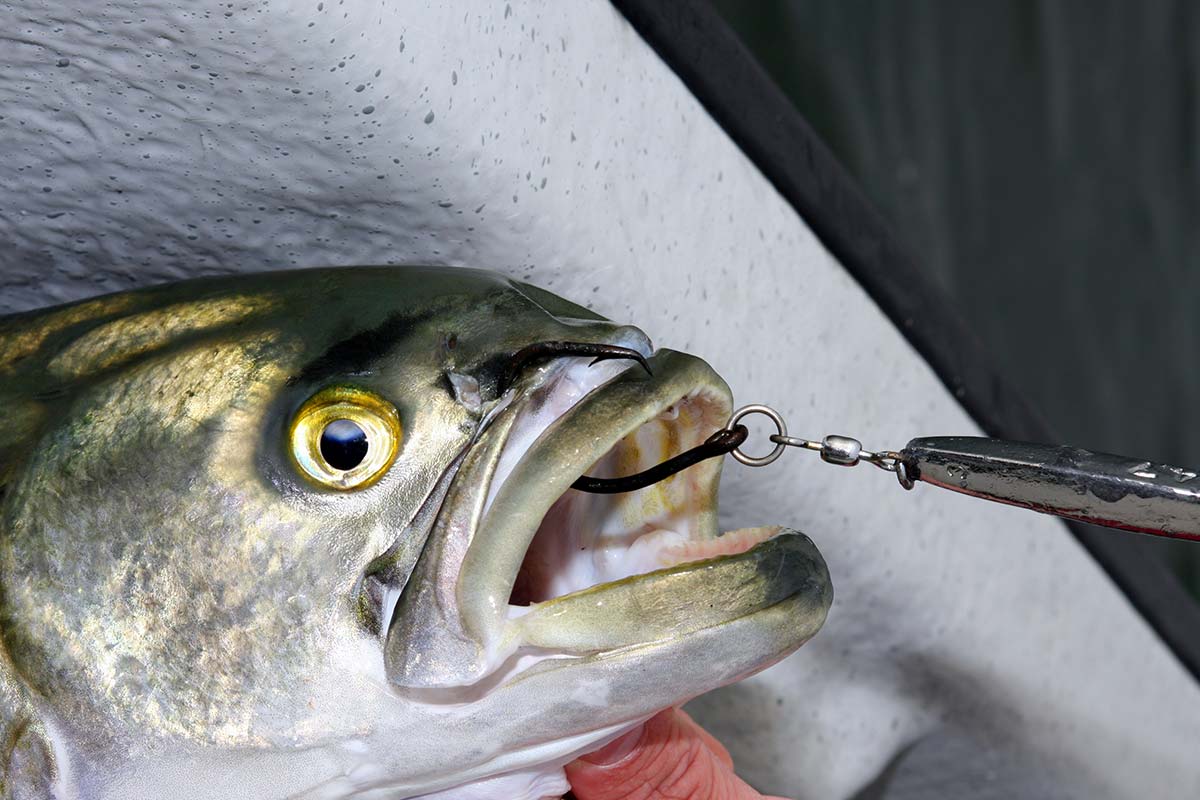
Custom rigging diamond jigs takes your fishing success to the next level. Here’s how to do it like a pro.
For fishing efficiency, it doesn’t get much better than diamond jigging. Diamonds can plummet in the strongest current or flutter down like wounded prey, yet they wobble irresistibly like a fleeing baitfish throughout the retrieve. During white-hot action, jigs have a speedy turnaround, enabling you release many fish in a short time without rebaiting a hook or replacing a soft plastic.
“One of the most effective and consistent ways to hook any of our gamefish is diamond jigging,” said Capt. Kerry Douton, who runs two charter boats out of Niantic, CT (jbtackle.com). “It’s a universal technique. Whether you’re working a rip, reef, bank or open water, you can catch lots of different fish by varying the size and presentation of diamond jigs. They’re very productive.
“Usually, the smaller the diamond jig, the better it produces. But a lot of guys mistakenly go the other way. They try to use something extra heavy so it sinks quickly. But lighter is better. I don’t like to use huge diamonds. Many fishermen in the Race go up to 16-ounce jigs, and there’s no reason for it. We use 8-ounce diamonds with superbraid line, and they fish well in the deep water. But inside Long Island Sound and similar waters, you’re able to use just 4 ounces in most spots.”
Despite their effectiveness you can still improve your jigs’ performance by giving them a “tune-up” by changing or adjusting the hardware, appearance, or configuration of a jig to better suit the conditions or targeted species. For optimal lure performance, start your tune-up with leader and line connections.
Leaders
Leaders for jigs include fluorocarbon, monofilament, nylon, and wire. Fluorocarbon is a good choice when fish are in shallow, clear water or for those predators with sharp eyes like tuna. But 40- to 80-pound mono is cheaper, easier to tie, and the best all-purpose choice for deep water and for fish that aren’t fussy.
Wire leader isn’t necessary—even for toothy bluefish—because predators rarely engulf a jig deeply enough to reach the leader. I never use wire because fish see it, and it inhibits lure action. Using heavy mono-type leader is also useful for taking a few hand wraps to lift feisty fish aboard.
Typical lengths for mono-type leaders can range from 30 to 40 inches when jigging against rugged structure or when fishing through schools of competitive bluefish swiping at the lure. Lines and leaders are almost always severed from aggressive “buddy” fish, not the fish on the hook. Reduce the leader length to 18 to 24 inches for black sea bass or schoolie stripers.

Connections
You can use one of at least three basic systems to connect a main line to a diamond-jig leader. The first connection is a line-to-line knot, like a double uni, which allows you to reel a long leader through the rod guides and onto the reel, which useful on party boats, for example, where mates prefer a long (10- to 15-foot) mono “buffer” between the lure and a braided main line, which helps them untangle multiple-line snarls.
The second connection is a heavy-duty barrel swivel, which remains permanently on the main line. Use a Palomar knot to tie braid to any swivel. To detach the jig for storage or transportation just snip the leader at the swivel, coil the leader, and clinch it back on next time. Use a swivel large enough to prevent it from slipping through the rod tip.
The third connection is using a Palomar knot to attach the main line to a cross-lock snap-swivel, which necessitates tying a loop knot in the leader to which you clip the snap. This method is handy for changing out different jig weights depending on the conditions. Your connection choice depends on application and preference.
You can tie a simple clinch knot to attach the leader to jig. But using a non-slip loop knot to the jig provides less restriction and more flutter action.
Hooks
The most beneficial tune-up for your jigs is to remove the factory-installed hook and replace it with one of a different style, size, strength, or sharpness.
When preparing diamonds for rugged bottoms or toothy species, always remove a treble hook and replace it with a single. Treble hooks snag bottom and lobster gear easily, and they make unhooking fish difficult and dangerous. They’re also more harmful to the fish when practicing responsible catch-and-release.
The basic, single diamond-jig factory hook is an O’Shaughnessy in 7/0 or 8/0. Only use 7/0s for targets like schoolie stripers, jumbo sea bass, and small bluefish. The thinner gauge of the 7/0 straightens when hung on a rock or under excessive pressure of big fish, especially when lifting a thrashing trophy from the water.
Treble hooks have an important use in diamond jigging, such as when targeting species like tuna intended for the cooler. Two of the best hooks on the market for this application are the Gamakatsu and Owner Treble 4X Strong.
Tuna pros like Capt. Ned Kittredge (ret.) feel most jigs “right off the shelf” need their treble hooks exchanged because those supplied are not suitable for tuna and similar powerful species. Kittredge removes the factory trebles and replaces them with a heavy-duty version. Many experts consider it an automatic upgrade for almost any factory-rigged diamond-style jig.

Another application for treble hooks is when targeting bottom species for eating. If you’re fishing against a gravel shoal or other mild structure, as opposed to rugged ledge, boulder fields, or wrecks, treble hooks are ideal for targeting sea bass, cod, pollock, and haddock.
One of the strongest split rings available for the hook-to-jig connection is the Owner Hyper Wire series. These are extra-heavy-duty split rings made from high-quality stainless steel, which have instant “spring-back” after opening. Owner is one of the companies providing pound-test ratings for its split rings.
A siwash is an upgrade hook style that fishes very well on a diamond jig. I’ve found the Mustad Stainless Steel Salmon Open-Eye 3X Strong (9510XXXS-SS) in 6/0 to 8/0 ideal for hooking and handling black sea bass, bluefish, and stripers. The hollow point helps quick penetration into rugged jaws, and the stainless-steel material prevents rust stains on storage surfaces.
Another specialized tune-up hook is a circle. To install one with a closed eye, remove the factory hook from a jig, then add a 50- to 75-pound-test stainless split ring to the fixed O-ring on the tail of the jig. These hooks are self-setting, provided you keep steady pressure on the fish once it’s taken the lure or bait. When you acquire the knack of fishing a circle, it’s surprisingly effective for bluefish and striped bass and greatly reduces gill hooking, although it may not fish quite as effectively as a J-hook does.
A different option for vertical jigging hooks to add a section of colorful plastic or rubber tubing over an existing O’Shaughnessy hook shank. This is a common dressing when jigging for cod, pollock, bluefish, and striped bass, and you can buy them factory rigged. In situations like cod fishing, the tubing resembles a sand eel. In other applications, it resembles the long tentacles on a fleeing squid. Tubes, however, are detrimental in fast, deep water like big rips because they create too much drag and slow your jig’s free-spool speed, thereby causing a diagonal drop rather than a more productive vertical drop. Another method is to attach white bucktail, providing a high-vis, low-drag alternative to a tube.
If you buy diamond jigs hook-less they usually come with a barrel swivel on one end. A common mistake is to attach the hook to solid eye ring and to attach the leader to the swivel. It should be the other way around. The swivel adds lifelike “beating tail” action to the hook, but more importantly, a hook attached directly without a swivel allows a fish to leverage its twists and head shakes against the heavy lure, thereby ripping it out of its mouth.
Touch-Ups
After a lot of use, even the most rugged diamond jigs get scarred and lose their shine. I use RUST-OLEUM Bright Coat Metallic Chrome spray paint for quick touchups. Or you can add sparkle and flash by applying waterproof reflective holographic/prism adhesive lure tape, including stick-on eyes, which are readily available on Amazon and in some tackle shops.
On a charter boat trip to the Race one fall day, I watched an old salt carefully applying and buffing chrome polish on his diamond jigs. For serious anglers, any small advantage is worth the effort of tuning a diamond jig.


